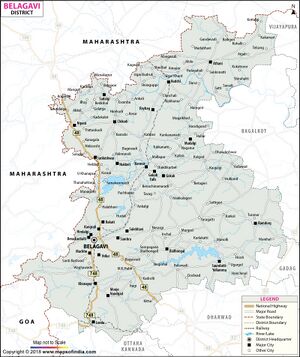Kittur
| Author:Laxman Burdak, IFS (R) |

Kittur (कित्तूर), also known as Kitturu and historically as Kittoor, is a taluka in the Belgaum district of the Indian state of Karnataka.
Origin
Variants
- Kitturu
- Kittoor (कित्तूर)
- Kirtipura (कीर्तिपुर) (मैसूर) (AS, p.193)
- Kitthipura (कित्थीपुर) = Kirtipura (कीर्तिपुर) (AS, p.189)
- Kirtipura (कीर्तिपुर) (मैसूर) (AS, p.193)
History
It is a place of historical importance because of the armed rebellion of Kittur Chennamma (1778–1829), Rani of the State of Kittur against the British East India Company, during which a British Commissioner, St John Thackeray was killed.
On the outskirts of the town lie the ruins of the palace within a fort. The palace was the residence of the Rani Chennamma.
In the 18th century, Kittur was ruled by the Marathas, until the Third Anglo-Maratha War, when it came under British suzerainty.[1]
In connection with a disputed succession to this chiefship in 1824, St John Thackeray, Commissioner of Dharwad, was killed in a battle when approaching the Kittur fort. Later another unit stormed Kittur and captured Queen Chennamma, who was imprisoned in Bailhongal Jail where she died. Rani Chennamma became a legend.
The town lends its name to the fictitious coastal town (Belgaum District has no coast, which rules out the real Kittur being the setting) 2008 novel Between the Assassinations by Aravind Adiga
कित्तूर
विजयेन्द्र कुमार माथुर[2] ने लेख किया है ...2. कित्तूर (AS, p.189) (मैसूर) प्राचीन पुन्नाडू की राजधानी कीर्तिपुर का वर्तमान नाम. यह कपिनी (कावेरी की सहायक नदी) के तट पर मैसूर के दक्षिण पश्चिम में स्थित है.
कीर्तिपुर
विजयेन्द्र कुमार माथुर[3] ने लेख किया है ...कीर्तिपुर (AS, p.193) (मैसूर) प्राचीन पुन्नाडू (5-10 वीं शती ई.) की राजधानी का वर्तमान नाम. यह कपिनी (कावेरी की सहायक नदी) के तट पर मैसूर के दक्षिण पश्चिम में स्थित है. इसका वर्तमान नाम कित्तूर है. (दे. पुन्नाडू)
External links
References
- ↑ Chitnis, Krishnaji Nageshrao (1994-01-01). Glimpses of Maratha Socio-economic History. Atlantic Publishers & Dist. ISBN 9788171563470.
- ↑ Aitihasik Sthanavali by Vijayendra Kumar Mathur, p.189
- ↑ Aitihasik Sthanavali by Vijayendra Kumar Mathur, p.193

